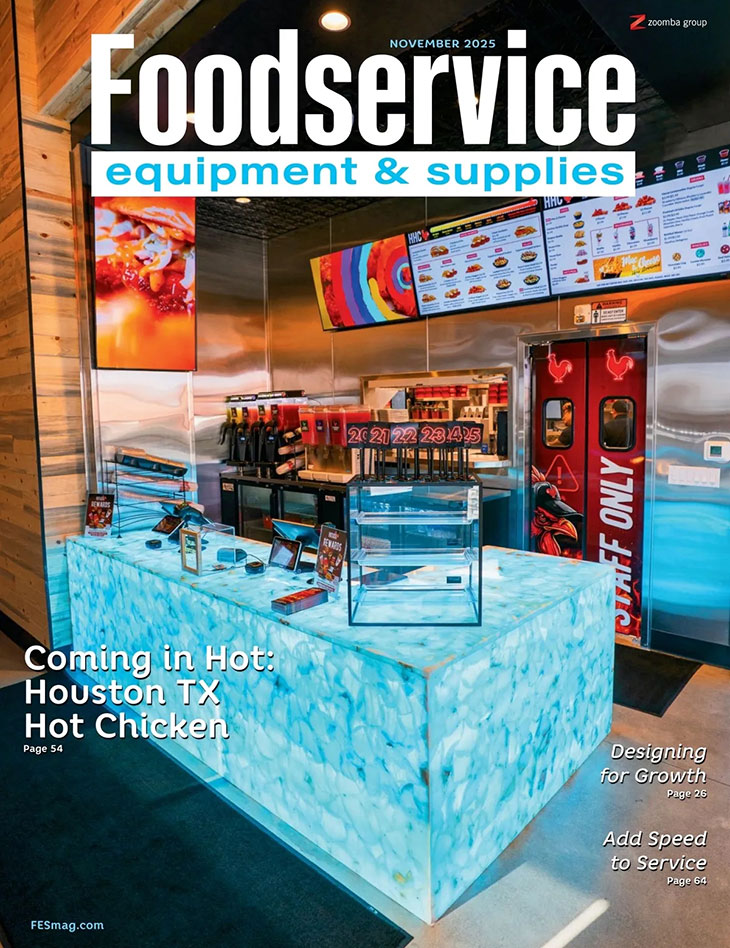Plus, Taco Bell’s big appetite for growth. Small business owners' uncertain outlook. These stories and more, This Week in Foodservice.
Since it was the 2025 edition of The NAFEM Show and I spent five days in Atlanta, here are five thoughts about this biennial event.
- There were plenty of new products to peruse while walking the show floor. Once again, the What’s Hot What’s Cool part of the show floor provided a museum-like experience where attendees can tour a space dedicated solely to new products. And, for the first time, The NAFEM Show offered guided tours of this space, which sold out. I saw groups of foodservice designers touring this on their own, taking pictures and notes while discussing the products amongst themselves. Some vendors hosted new product launches in their booths and used the show to unveil new directions for their company, which were very well attended, too. In other words, foodservice pros from all industry segments remain as hungry for new products as ever.
- Artificial intelligence is slowly working its way into the foodservice ecosphere. Some ovens used cameras to scan food items and trigger pre-programmed recipes to make cooking easier and more consistent. Service agents report using generative AI to help with scheduling calls, managing parts inventory, and even cutting purchase orders for equipment that’s under warranty. These developments take touches out of the system that make businesses more effective and efficient.
- Tariff talk was top of mind. There was lots of conversation about the potential impact tariffs imposed by the Trump Administration, including on items like stainless steel, aluminum, and component parts, will have on the pricing and availability of foodservice equipment and supplies in the coming months. There was also discussion about how this will impact service agents’ ability to get the replacement parts they need for repairs and planned maintenance. The short answer is nobody really knows, at least right now, as the situation remains very fluid and very top of mind for everyone involved.
- The supply chain often pushes innovation, but is the industry ready for it? Equipment connectivity, for example, has been around for a long time but has been slow to catch on in the industry. As someone said during the show, generating data is not hard. What is hard is understanding how to apply that data to solve problems. The biggest challenge most operators seek to address is generating positive customer experiences, particularly as consumer expectations rise and disposable personal income dips. As a result, operators will continue to focus more on customer-facing solutions, at least in the near term. Moreover, it’s the larger chains that often drive innovation in the foodservice industry, but they move at their own, very deliberate pace. Still, it’s only a matter of time before back of the house innovation accelerates.
- The U.S. Culinary Open generated a healthy buzz on the show floor. The inaugural competition drew high-caliber chefs from around the country and had audiences captivated. The kitchens looked great and provided another way to see some of the equipment and supply items on display in action, too.
Foodservice News
- Restaurant industry performance ticked slightly upward in January, per the National Restaurant Association. The organization’s Restaurant Performance Index came in at 101.1% in January, which is 1.0% greater than December. Any reading greater than 100% indicates the industry is in expansion mode. Same-store sales increases and growth in customer traffic drove the increases, per the NRA. Restaurant operators remain cautiously optimistic about sales in the months ahead. Specifically, 49% expect their sales volume in six months to be higher than it was during the same period in the previous year. That was unchanged from the previous three months. Also, 22% think their sales in six months will be lower than it was during the same period in the previous year, while 29% think their sales will remain about the same.
- Sales of foodservice equipment and supplies totaled $17 billion in 2023, per the latest Size & Shape of the Industry study published by the North American Association of Food Equipment Manufacturers. The average sales among NAFEM members reporting their data was $98.3 million in 2023. And more than half of reporting companies expect sales to increase by more than 10%, with members expecting the greatest increases coming from storage and handling equipment and refrigeration and ice machines. Additional information about the study is available via the NAFEM website.
- Hot chicken chain Urban Bird has acquired Bun Slut, a gourmet smash-burger chain. While Bun Slut will “retain its signature brand identity and menu,” per a release, some menu updates have been made, including the addition of sliders and seasoned fries.
- On the Border is the latest casual dining chain to file for bankruptcy. In doing so, the chain cited customers dining out less, rising minimum wages and other economic pressures, per multiple published reports, including this one from ABC News. In recent months, casual dining chains Red Lobster and TGI Fridays filed for bankruptcy.
- Big Chicken will get a new teammate as Craveworthy Brands becomes a managing partner, investor, and stakeholder in the emerging restaurant chain. Big Chicken was founded by hall of fame basketball player Shaquille O'Neal, who maintains an interest in the business. Other backers of the fast-casual chain include JRS Hospitality and Authentic Brands Group. Current Big Chicken CEO Josh Halpern will continue overseeing the chain, working alongside Craveworthy Brands CEO and founder Gregg Majewski. Craveworthy will manage and “provide expertise across key functions such as operations, training, supply chain management, culinary development and customer service,” per a release announcing the deal.
- C-store chain 7-11 could go public as soon as 2026, per an Associated Press report. This marks the latest in a series of steps7-11 parent company Seven & i is taking to fend off a takeover bid from Couche Tard, a Canadian company which owns c-store chain Circle K. Seven & i plans to sell some non-convenience store assets, including supermarkets and other retail stores, to Bain Capital for $5.4 billion. The transaction is scheduled to close in September.
- Taco Bell wants to drive its average unit volumes to $3 million, per a Restaurant Dive story. This would be up from $2.2 million last year. The quick-service restaurant chain feels it can achieve this goal via its Relentlessly Innovative Next Generation Growth (RING) plan, which includes an emphasis on menu development and digital sales.
Economic News
- Uncertainty is high and rising on Main Street for many reasons. Those were the words of Bill Dunkelberg, the chief economist for the National Federation of Independent Businesses. And the NFIB has the data to back that up. Small business owners who expect the economy to improve in the coming months came in at 37% in February, which is down 10% from January, per the NFIB Small Business Optimism Index. The net percent of owners raising their average selling prices increased 10 points from January to a net 32%. This is the largest monthly increase since April 2021 and third largest in the study’s history.
- The U.S. economy added 151,000 positions in February, and the unemployment rate remained steady at 4.1%, the U.S. Bureau of Labor Statistics reported. This was weaker than expected, as economists had projected the economy would add 170,000 jobs in February, per a CNBC story. Employment trended up in health care, financial activities, transportation and warehousing, and social assistance. Federal government employment declined.
- Private sector employment increased by 77,000 jobs in February and annual pay grew 4.7%, per the ADP National Employment Report. This is significantly 109,000 fewer positions than were added in January and 71,000 fewer jobs than Dow Jones economists had projected for the month, per a CNBC story. The leisure and hospitality segment led the way by adding a net positive 41,000 jobs. “Policy uncertainty and a slowdown in consumer spending might have led to layoffs or a slowdown in hiring last month. Our data, combined with other recent indicators, suggests a hiring hesitancy among employers as they assess the economic climate ahead,” per Nela Richardson, ADP’s chief economist.
- U.S.-based employers announced 172,017 job cuts in February, per data from Challenger, Gray & Christmas. It is the highest monthly total since July 2020 when 262,649 cuts were announced. This also represents a 245% increase compared to January. More than one third of the job cuts came due to the Trump Administration’s efforts to pare down the size of the Federal Government, per a CNBC story.
- Initial jobless claims decreased by 21,000 for a total of 221,000 for the week-ending March 1, 2025, per data from the U.S. Department of Labor. The 4-week moving average was 224,250, an increase of 250 from the previous week.
- Consumer credit increased at a seasonally adjusted annual rate of 4.3% in January, the U.S. Federal Reserve reported. Revolving credit increased 8.2%, while nonrevolving credit increased 3.0%.
- New orders for manufactured goods increased 1.7% in January, compared to the previous month, per data from the U.S. Census Bureau. January’s growth spurt comes after a 0.6% December decline. Shipments and unfilled orders increased 0.4% and 0.2%, respectively.
- Nonfarm business sector labor productivity increased 1.5% in the fourth quarter of 2024, the U.S. Bureau of Labor Statistics reported. Output increased 2.4% and hours worked increased 0.8%. Compared to the same quarter a year ago, nonfarm business sector labor productivity increased 2.0% in the fourth quarter of 2024.



